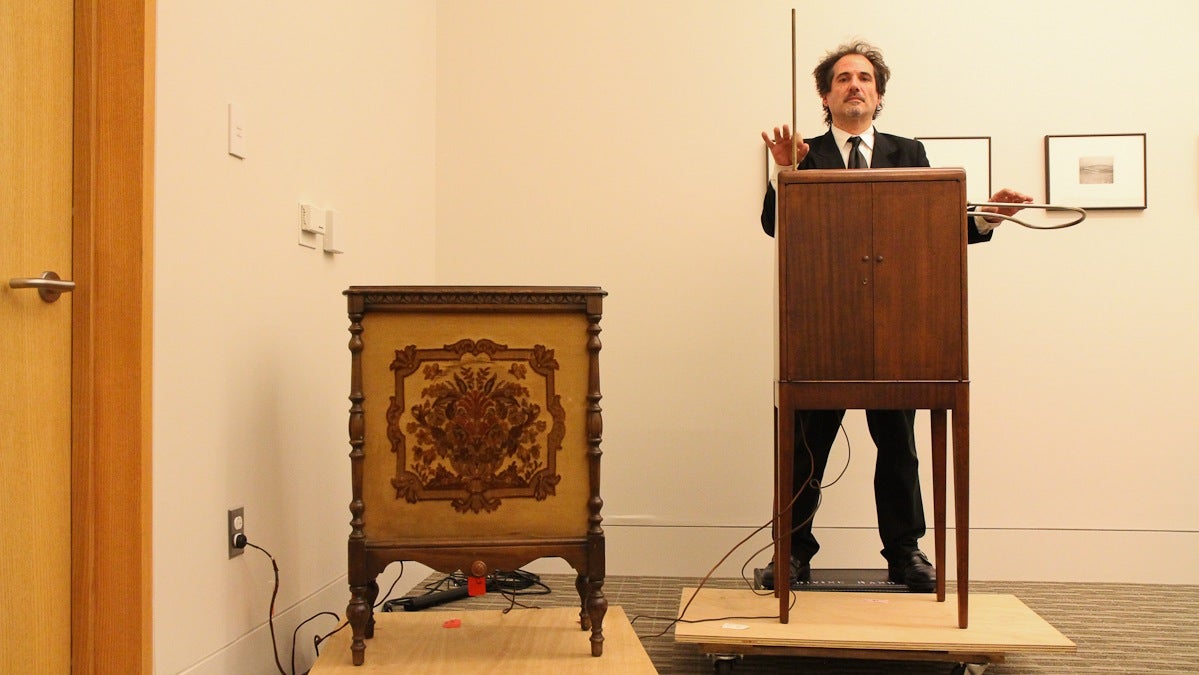The weird, untouchable theremin is still king of the scary soundtrack
Listen
Mano Divina plays a rare theremin at the Franklin Institute. Only 500 were built in 1929 and are based on the original design by Leon Theremin. (Kimberly Paynter/WHYY)
You know that sound that makes the hair stand up on the back of you neck? That “watch out because the alien’s huge, slimy tentacles are slithering closer and closer” sound?
Lots of classic 1950s sci-fi horror movies relied on an electronic musical instrument called a theremin to create that tone of other worldly dread.
The instrument is named for its inventor, Leon Theremin who created it in 1920. He was born in Russia as Leve Termin. He studied music and had been fascinated by electronics and physics from an early age. He combined those passions into his unique namesake instrument.
Theremin himself had an amazing and bizarre life, from creating the odd instrument that bears his name to spying for Russia. Composer and scholar Albert Glinsky’s biography of the inventor, “Theremin: Ether Music and Espionage” is a must read for anyone who wants to know the man and the instrument.
What most people find amazing about the theremin is how it works. The human hand does not come into contact with the instrument, instead players wave their hands around two antennae that emerge from either side.
“In the case of a piano you have a hammer that hits the string, the string vibrates. And that vibration creates a sound,” said Frederic Bertley, Senior Vice President of Science at The Franklin Institute.
That’s not what happens with a theremin.
“The really neat thing about the theremin,” said Bartley, “is instead of using frequency and waves coming from percussion or hitting, it works by impactig the electromagnetic field.”
The electronics within the theremin create an electro magnetic field—a radio wave.
Andrew Baron knows theremins inside and out…literally. He is a conservator and restorer of rare theremins who has worked on instruments designed by the inventor himself. Along with Mike Buffington he founded the website RCAtheremin.com, a go-to site for theremin enthusiasts and the only site on the Web that tracks and registers vintage instruments.
“The theremin itself, its principle of operation, is actually relatively simple,” said Baron.
Keep in mind that’s coming from someone who has been taking apart and reassembling tube radios and other complex electronic devices since he was 12 years old. So for Baron, “simple” is a relative term.
He broke it down like this, “A theremin produces an electric radio wave. That radio wave is something that we can’t hear.”
Baron says the wave that is produced is too high for human hearing, but when a performer places her hands in that field in that radio wave, the frequency shifts. That shifted frequency is still beyond what humans can hear, but inside the theremin circuitry a rado oscillator converts that frequency into an audible sound.
As you move your hands around between the antennas the sound changes with each movement. If you’re good, the ear hears music. If you aren’t, the machine squawks, shrieks, grunts, and generally lets you know it is not impressed with your hapless flailing around in it’s electromagnetic field.
But if you are good, realy good, you can make a theremin sing. Mano Divina has devoted over a decade to mastering the instrument.
“Thirteen years ago I bought a theremin as a novelty,” he says, “and within a week it was all I wanted to do.”
Divina leads The Divine Hand Ensemble, a modern classical orchestra that showcases his virtuoso theremin and fully utilizes the instrument’s creepy, Halloween-y sound. They’ve played concerts of funerary music in cemeteries. The ensemble was recently featured on WHYY’s Friday Arts program.
Playing a theremin requires a unique skill.
“There’s no tactile memory,” says Divina.
“I can’t touch anything like a piano, where you put your fingers on things. There’s no visual memory like a guitar fret. I have to guess where everything is.”
It’s an understatement to say Divina is passionate about the theremin—his name means “divine hand.” On a recent fall day, he came to the Franklin Institute to play a rare theremin, manufactured by RCA in 1929. Only 500 were manufactured and only a handful still exist.
Andrew Baron restored the Franklin Institute’s model and has kept it in playing condition.
Divina was impressed by the sleek simple cabinet that housed the 85-year-old instrument and was not disappointed when he turned it on. It may be vintage but it can still channel that trademark eerie sound.
Davina treated listeners to a few quavery, scary selections from Hitchcock to Scooby Doo.
“It would’ve disappeared out of history entirely,” said Davina, “If it wasn’t for the fact that a few people got the idea of ‘I don’t know how this works, but if I go like this it sure sounds like a ghost.”
The theremin is the grandaddy to all electronic synthesized musical instruments. It has evolved far beyond horror music sound effects, taking its place on stage next to concert masters and rock stars.
One piece of theremin trivia that all the experts want you to know is that the instrument in the Beach Boys’ song Good Vibrations is not really a theremin. It is a synthesized instrument, but the player has to touch it—not a true theremin, at all.
So now you know.
WHYY is your source for fact-based, in-depth journalism and information. As a nonprofit organization, we rely on financial support from readers like you. Please give today.



